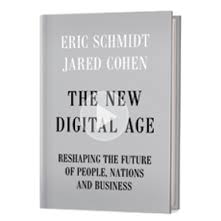
For those willing to take the leap into The New Digital Age, take some comfort in knowing that it isn’t another technocornucopian book about widgets and gadgets. It’s instead concerned with humans and our role in our digital future (‘The importance of a guiding human hand in the new digital age.’) Schmidt and Cohen remind us that despite what communication technology may allow, what we do with it us up to us. In an increasingly tech deterministic world, this core message bears repeating (so read this paragraph again).
And now for the big caveat: A book that portends the coming digital age from two of the world’s most prescient thinkers has relegated dialog about health to just a couple of pages. Really? The collision course of health and technology is perhaps modern civilization’s most pressing angle. This omission represents a lost opportunity for readers.
The authors make several references to the coevolution of two civilizations, one virtual and one physical. Fascinating.
“These civilizations will coexist in a more or less peaceable manner, with each restraining the negative aspects of the other. The virtual world will enable escape from the repression of state control, offering citizens new opportunities to organize and revolt; other citizens will simply connect, learn and play. The physical world will impose rules and laws that help contain the anarchy of virtual space and that protect people from terrorist hackers, misinformation and even from the digital records of their own youthful misbehavior…”
The concluding thoughts were both powerful and reassuring:
“The case for optimism lies not in sci-fi gadgets or holograms but in the check that technology and connectivity bring against the abuses, suffering and destruction in our world. When exposure meets opportunity, the possibilities are endless. The best thing anyone can do to improve the quality of life around the world is to drive connectivity and technological opportunity. When given the access, the people will do the rest. They already know what they need and what they want to build, and they’ll find ways to innovate with even the meagerest set of tools. Anyone passionate about economic prosperity, human rights, social justice, education or self-determination should consider how connectivity can help us reach these goals and even move beyond them. We cannot eliminate inequality or abuse of power, but through technological inclusion we can help transfer power into the hands of individual people and trust that they will take it from there.”
While a provocative read, I’d recommend a pass on The New Digital Age for my health-focused readers. A must-read, however, for budding futurists.
Amazon links represent affiliate links